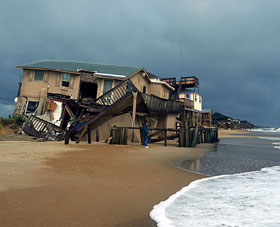Hurricanes and Global Warming
Air Date: Week of September 24, 2004
As images of hurricane destruction pepper the news, host Steve Curwood talks with Kevin Trenberth of the National Center for Atmospheric Research, about the link between hurricane intensity and global warming.
Transcript
CURWOOD: So what about the question regarding the current batch of devastating hurricanes and any connection to global climate change? There have been a number of stories carried by other news outlets assuring the public that climate change has nothing to do with these storms, but we thought we’d check our own sources.
So we turn now to Kevin Trenberth. He’s head of the climate analysis section at the National Center for Atmospheric Research in Boulder, Colorado. He’s also a leader of a team of scientists of Intergovernmental Panel on Climate Change that is coordinating reports of the latest scientific research on observed changes. Mr. Trenberth, please tell us, based on the best science you know, what’s the impact of climate change on hurricanes?
TRENBERTH: Well, the way I think of it is that the hurricanes would be there anyway, but the global climate change, and global warming in particular, creates a different background environment in which the hurricanes are working. And in particular the sea-surface temperatures are a little warmer, the whole environment is a bit wetter, a bit moister, there’s more humidity, and that’s the main fuel for the hurricanes. As a result, the hurricanes are a bit more intense, and in particular the rainfall that comes out of them is somewhat greater than it would otherwise be. And the best estimate we have is somewhere in the neighborhood of ten to 15 percent over the last 30 years.
CURWOOD: So what you’re telling me is that we’re not seeing any more hurricanes than we might have seen in the past, but the ones that we are seeing are more intense?
TRENBERTH: Well, that applies to any tropical disturbance, so there may be a tropical disturbance that sort of gets pushed across the threshold and then counts as a hurricane whereas otherwise it wouldn’t. But in general that is the idea, yes, that things are a bit more intense and more rainfall coming out of these things.
CURWOOD: Now, on some of the observations for global climate change we’ve seen the seasons shifting – spring coming earlier in some places, fall a little bit later. What about the season for hurricanes? What changes in the timing of hurricanes might we be seeing?
TRENBERTH: It may start earlier and last longer, and it may also be a little bit more extensive. There may be some regions of the world, in the tropics, where hurricanes form that otherwise they might not have been quite vigorous enough to be called a hurricane.
CURWOOD: How much is the weather changing?
TRENBERTH: Well this is how climate change actually gets manifested, of course. The changes in the hurricanes are consistent with the changes we see in precipitation across the United States. So we’re getting fewer moderate rains and more heavy rains and more instances of potential flooding as a result of that.
CURWOOD: And why are these changes happening?
TRENBERTH: The global warming aspects relate to the changes in composition of the atmosphere. The build-up of carbon dioxide and other greenhouse gases in the atmosphere, which is related to the burning of fossil fuels. And so this relates to our energy use. And we’ve got very clear evidence that the composition of the atmosphere is changing. These gases are greenhouse gases, so they trap the earth’s radiation back out to space and they produce a warming – sort of like acting as a blanket on the planet Earth. And this means that the global mean temperature goes up. But also global water vapor in the atmosphere goes up, and that provides even a feedback because water vapor is itself a greenhouse gas.
CURWOOD: What does this likelihood of stronger hurricanes mean for someplace like the Everglades?
|
|
CURWOOD: So, New Orleans is really looking down the barrel of a gun, is what you’re saying to me? TRENBERTH: I think that’s true in the longer-term, yes. CURWOOD: Give me the basics, here. How does a hurricane get formed? TRENBERTH: Well a hurricane is a collective of individual thunderstorms, and there are disturbances in the Atlantic, there are disturbances which come off of Africa which propagate in the trade winds out into the Atlantic. And then the question is, is this enough to organize the thunderstorms into a collective where they can feed back on themselves and start a circulation that ends up as a tropical storm and ultimately a hurricane. CURWOOD: Why do they seem to almost always end up in this rather narrow part of the United States and the Caribbean? It’s only really a few hundred miles wide that these storms seem to come to. TRENBERTH: Well the western part of the tropical oceans is where the warmest water lies, and so hurricanes don’t form in the eastern part of the oceans, for the most part, although there are a few right along the coast of California in the Pacific. But out in most of the central and eastern Pacific hurricanes don’t usually form. On the far western Pacific they’re actually called typhoons, and over in the Indian Ocean they’re called cyclones. CURWOOD: Kevin Trenberth is head of the climate analysis section at the National Center for Atmospheric Research in Boulder, Colorado. Thanks for taking this time with me today Kevin. TRENBERTH: You’re most welcome. [MUSIC: David Grubbs “Hurricane Season” A GUESS AT THE RIDDLE (Fat-Cat Records – 2004)] CURWOOD: To hear an extended version of our interview with Kevin Trenberth, go to our website, living on earth dot org. Links
|

 Hurricane damage from Hurricane Dennis (Credit: ©University Corporation for Atmospheric Research, Photo by Carlye Calvin)
Hurricane damage from Hurricane Dennis (Credit: ©University Corporation for Atmospheric Research, Photo by Carlye Calvin) 



